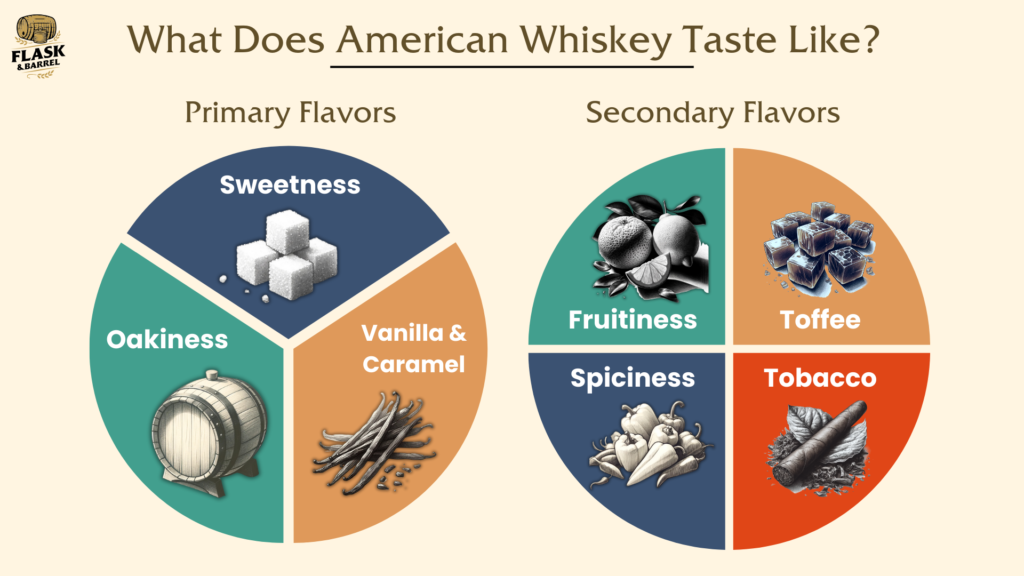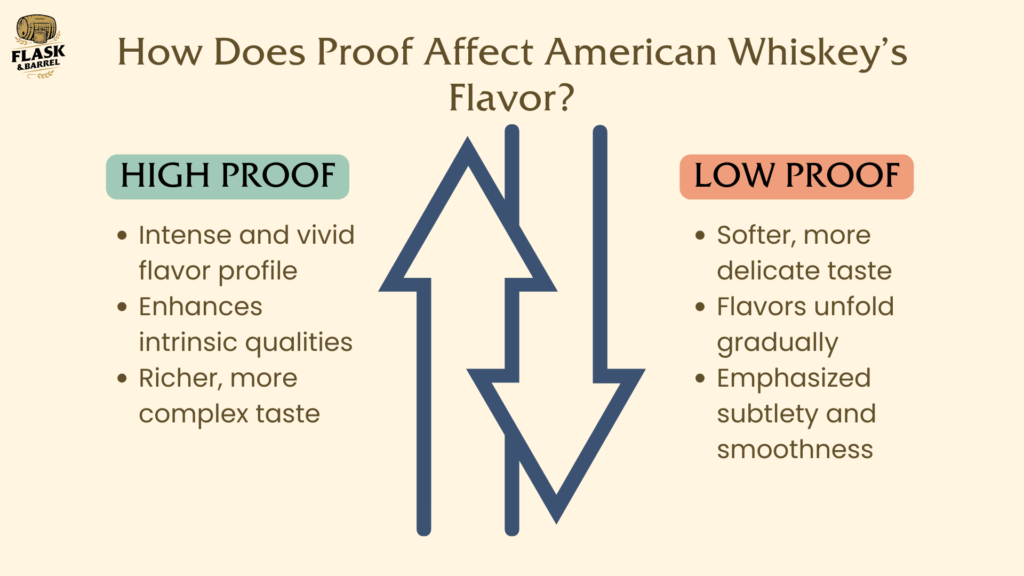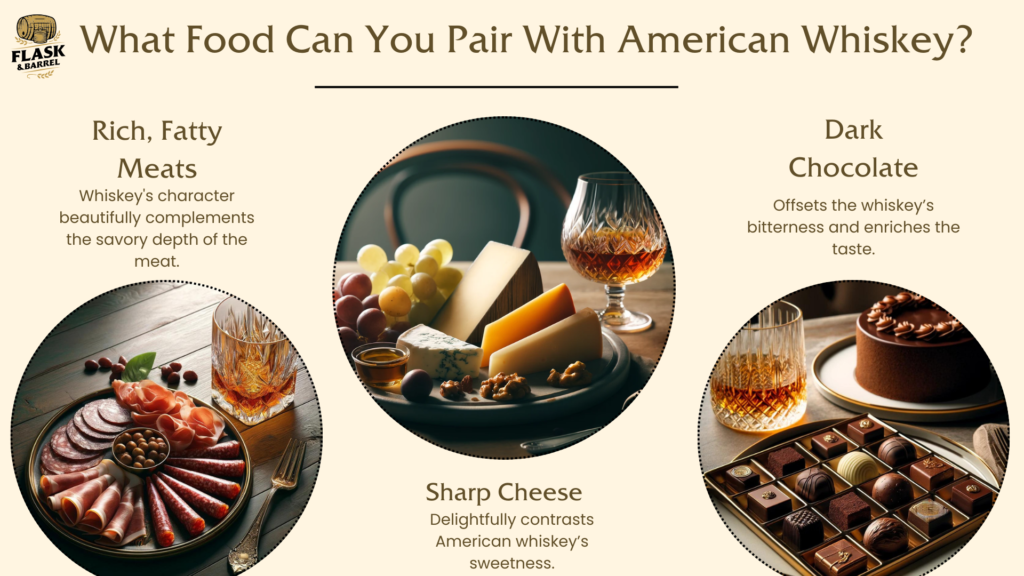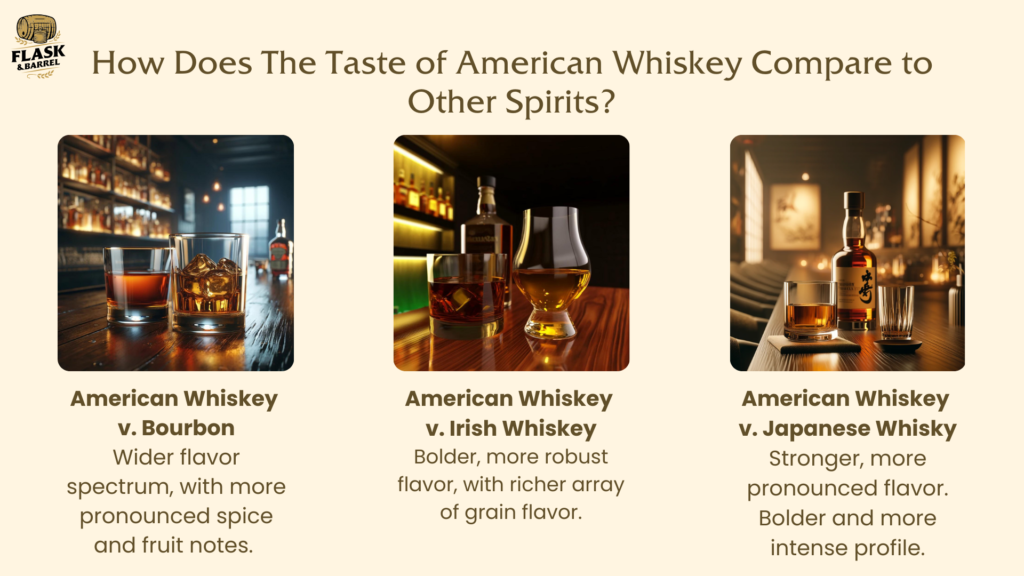Not to be overlooked, American Single Malt is emerging as a noteworthy contender, offering a nuanced and sophisticated option for enthusiasts. Diving deeper, each type of American whiskey showcases its own array of tastes, production methodologies, cultural significance, and pairing potentials with food. The following sections will delve into these facets in greater detail, enriching the appreciation for what makes American whiskey an esteemed and multifaceted spirit worldwide.
What Does American Whiskey Taste Like?
American whiskey unfolds a rich tapestry of flavors, underpinned by a foundational sweetness that is intricately layered with complex notes of oak, vanilla, and caramel. This initial sweetness often transitions into secondary flavors including fruitiness, spiciness, toffee, and tobacco, creating a multifaceted taste experience that is both robust and nuanced. The flavor profile of American whiskey is significantly influenced by its aging process, the distilling methods employed, and the specific grains used in its mashing process.

Furthermore, the proof at which the whiskey is bottled can greatly affect its taste; higher proof whiskeys tend to deliver a more intense flavor experience, while lower proof whiskeys may offer a smoother, more mellow taste. American whiskey’s distinct taste can be savored neat, on the rocks, or as a key component in a variety of cocktails, making it a versatile spirit that appeals to a wide range of palates. Whether enjoyed in its purest form or as part of a complex drink, American whiskey presents a unique and engaging flavor journey that is both deeply traditional and excitingly varied.
What are the Primary Flavors in American Whiskey?
At the heart of American whiskey lies a sweetness that is both inviting and foundational, setting the stage for a complex flavor journey. This sweetness is intricately complemented by the oakiness derived from aging in charred oak barrels, lending the spirit a depth that is both earthy and profound. Vanilla and caramel notes weave through the profile, adding a smooth, creamy texture that enriches each sip with warmth and complexity.
These primary flavors not only define the character of American whiskey but also serve as a canvas for the emergence of secondary flavors, creating a spirit that is as layered and dynamic as it is approachable.
Sweetness
At its essence, American whiskey captivates with a sweetness that warmly greets the palate. This fundamental sweetness, emerging from the corn or other grains in the mash, establishes a rich, inviting baseline for the spirit’s flavor narrative, encouraging deeper sensory exploration.
Oakiness
The oakiness in American whiskey, a direct product of its aging in charred oak barrels, introduces a robust and earthy dimension. This layer of complexity not only complements the initial sweetness but also enriches the whiskey with a profound depth, adding a nuanced, textured character to each sip.
Vanilla and Caramel
Notes of vanilla and caramel are quintessential to the American whiskey experience, weaving through the flavor profile with a smooth, creamy essence. These flavors, born from the whiskey’s interaction with the oak during aging, envelop the palate with a comforting, rich finish, perfectly rounding out the primary tastes and exemplifying the spirit’s sophisticated warmth.
What are the Secondary Flavors in American Whiskey?
Beyond the foundational sweetness, oakiness, and vanilla-caramel richness, American whiskey reveals a complex spectrum of secondary flavors that add depth and intrigue. Fruitiness offers a refreshing contrast with notes ranging from crisp apples to lush berries, introducing a bright layer to the whiskey’s profile. Spiciness, often a hallmark of rye-influenced whiskeys, delivers a warm, tingling complexity that perfectly complements the underlying sweetness.
The indulgent flavor of toffee contributes a buttery richness, while tobacco notes lend an earthy, mature depth. These secondary flavors, born from the nuanced interplay of ingredients, aging, and distillation processes, enrich the American whiskey experience, making each sip a journey through a landscape of taste and aroma.
Fruitiness
The Fruitiness aspect in American whiskey brings a delightful spectrum of flavors, from the crisp and tangy notes of apples to the rich and sweet undertones of berries. This dimension introduces a refreshing vibrancy, enhancing the whiskey’s complexity with a burst of natural sweetness.
Spiciness
Spiciness, particularly pronounced in whiskeys with a rye component, delivers a warm, tingling complexity. This attribute beautifully balances the inherent sweetness of the whiskey, adding a lively, invigorating layer to its flavor profile.
Toffee
A rich, buttery Toffee note contributes decadence to American whiskey, deepening its flavor landscape with a luxuriously indulgent touch. This element adds a smooth, caramel-like sweetness, elevating the whiskey to new heights of sophistication.
Tobacco
Tobacco notes in American whiskey offer an earthy, mature character. This flavor adds a robust, refined depth, appealing to connoisseurs who appreciate a whiskey with a bold, distinctive edge, marking a journey into the more complex nuances of the spirit.
What Gives American Whiskey its Flavor?
The rich, multifaceted flavor of American whiskey is crafted through a symphony of choice of grains, unique aging processes, and specific distillation techniques. Each element plays a vital role in shaping the spirit’s distinctive taste. The grains used in the mash bill, such as corn for sweetness, rye for spiciness, and barley for a smooth, malty character, lay the foundational flavors.
The aging process in charred oak barrels introduces depth and complexity, infusing the whiskey with notes of vanilla, caramel, and oakiness. Distillation methods, whether through traditional pot stills or modern column stills, concentrate the whiskey’s essence, further defining its final flavor profile. Together, these factors combine to create the rich tapestry of tastes that define American whiskey.
How Does Aging, Distilling, and Mashing Impact the Flavor of American Whiskey?
The distinctive flavors of American whiskey are intricately shaped by the interplay of aging, distilling, and mashing processes. Aging in charred oak barrels is crucial, infusing the spirit with rich notes of vanilla, caramel, and oakiness. The duration of aging significantly influences the whiskey’s complexity and depth.
Distilling serves to concentrate the whiskey’s flavors, with the choice between pot or column distillation affecting the final taste profile and purity of the spirit. Mashing, the fermentation of selected grains, lays the foundation for flavor; corn brings sweetness, rye adds spiciness, and barley offers a smooth texture. These processes collectively define the unique and varied flavor spectrum of American whiskey, crafting a spirit that is as complex as it is captivating.
How Does Proof Affect American Whiskey’s Flavor?
The proof of American whiskey, indicative of its alcohol content, significantly influences its flavor dynamics. High proof whiskeys, characterized by a higher alcohol concentration, are known for their intense and bold flavor profiles. These whiskeys offer a robust tasting experience, accentuating the spirit’s depth and complexity.

Conversely, low proof whiskeys present a smoother, more mellow taste. They are more approachable, with their subtle flavors unfolding gently on the palate. The variance between high and low proof thus shapes the whiskey’s overall character, appealing to a broad spectrum of tastes and preferences.
High Proof
High proof American whiskeys stand out for their intense and vivid flavor profiles, driven by a higher alcohol concentration. This elevated alcohol level enhances the whiskey’s intrinsic qualities, offering a bold and dynamic tasting experience. High proof selections cater to aficionados who appreciate a rich, complex exploration of flavors.
Low Proof
Conversely, low proof American whiskeys provide a softer, more delicate taste. The reduced alcohol content allows the whiskey’s flavors to unfold gradually, presenting a nuanced and refined drinking experience. Ideal for those who favor a gentler, more accessible whiskey, low proof options emphasize subtlety and smoothness.
Does American Whiskey Taste Better in a Cocktail?
Whether American whiskey tastes better in a cocktail is a matter of personal preference. For purists, the intricate flavors of American whiskey are best savored neat or with a splash of water, highlighting the spirit’s rich complexity and depth. However, if you’re wondering what to mix with American whiskey, then you’ve got plenty of options.
Its robust character can transform a cocktail, introducing a symphony of flavors that meld seamlessly with other components. Cocktails offer a platform to display the versatility of American whiskey, appealing to those who might shy away from it in its undiluted form. In essence, the decision to enjoy American whiskey straight or as part of a cocktail boils down to individual taste, with each option presenting its own unique experience.
What Food Can You Pair with American Whiskey?
Pairing food with your drink is another way to serve American whiskey. It can significantly enhance the culinary experience, creating a delightful interplay of flavors. Rich, fatty meats such as steak or barbecue are classic pairings, where the whiskey’s robust character beautifully complements the savory depth of the meat. For those seeking contrast, sharp cheeses or dark chocolate offer an intriguing balance, with the whiskey’s inherent sweetness offsetting the bitterness and enriching the taste.

Seafood, especially smoked salmon, presents another excellent pairing option, with the whiskey’s smokiness harmonizing with the fish’s flavors. The key to successful pairings lies in matching the whiskey’s specific flavor profile with complementary food choices, encouraging experimentation and discovery to find the perfect match.
Does American Whiskey Lose its Taste Over Time?
American whiskey, once it has been bottled, retains its flavor profile over time, assuming it is stored under proper conditions. Unlike wine, which may mature and gain complexity in the bottle, whiskey’s aging process stops once it is sealed in the bottle. Factors such as exposure to light, extreme temperatures, or air can negatively impact the whiskey, potentially altering its original taste.
Thus, to preserve the whiskey’s intended flavor, it is essential to keep the bottle sealed and stored in a cool, dark place. Remarkably, an unopened bottle of whiskey can maintain its taste for decades, making whiskey not only a delightful spirit but also a timeless addition to any collection.
Does the Region Where American Whiskey is Produced Affect its Flavor?
The region where American whiskey is produced significantly influences its flavor profile. Local climate, water source, and the availability of specific grains all play pivotal roles in shaping the whiskey’s taste. For example, Kentucky’s limestone-filtered water, renowned for its purity, is a key contributor to the distinctive taste of Kentucky Bourbon.
Similarly, Tennessee’s cooler climate affects the aging process, imparting a unique smoothness and depth to the whiskey produced there. The terroir, or the natural environment including the soil, topography, and climate, imparts unique characteristics to the whiskey, making the production region an integral component of its identity and flavor.
How Does The Taste of American Whiskey Compare to Other Spirits?
American whiskey stands out in the spirits world with a unique flavor profile, deeply rooted in its ingredients, aging process, and regional production nuances. Compared to bourbon, a specific type of American whiskey known for its sweet, rich vanilla and caramel notes, American whiskey encompasses a broader flavor spectrum, influenced by the variety of grains used and distinct distillation techniques. In contrast to Irish whiskey, which is typically smoother and lighter, American whiskey often exhibits a bolder, more robust character.

Against Japanese whisky, known for its precision, elegance, and balance, American whiskey may present a more intense and varied flavor experience. Each spirit, with its own heritage and production philosophies, contributes a unique set of flavors to the diverse tapestry of global spirits, positioning American whiskey as a distinct and versatile choice.
The Taste of American Whiskey vs. Bourbon
American whiskey and bourbon are closely related, yet their flavor profiles often diverge due to distinct production standards. Bourbon, recognized for its sweet, full-bodied flavor with prominent vanilla and caramel notes, must be crafted predominantly from corn and aged in new charred oak barrels. American whiskey, while potentially sharing these characteristics, offers a wider flavor spectrum that may include more pronounced spice or fruit notes, influenced by the variety of grains used and the specific distillation techniques employed.
The Taste of American Whiskey vs. Irish Whiskey
Irish whiskey is celebrated for its smooth, light character, a result of its triple distillation process and the use of unmalted barley. This contrasts with American whiskey, which typically exhibits a bolder, more robust flavor. The difference stems from the production methods, with American whiskey often highlighting a richer array of grain flavors and a more significant wood influence from its aging process.
The Taste of American Whiskey vs. Japanese Whisky
Japanese whisky, inspired by Scottish traditions, is noted for its precision, balance, and subtle complexity, offering a delicate mix of sweet and smoky notes with a smooth finish. In contrast, American whiskey tends towards a stronger, more pronounced flavor spectrum, with a greater emphasis on the characteristics imparted by aging in charred barrels, resulting in a distinctly bolder and more intense taste profile.
How Should You Drink American Whiskey?
Enjoying American whiskey is a deeply personal experience, with various methods to suit individual tastes. For those who prefer to savor the spirit’s intricate flavors in their purest form, drinking it neat at room temperature is ideal. This approach allows the whiskey’s complex character to be fully appreciated without any dilution.

Others may opt for a splash of water or an ice cube, which can help to open up the whiskey, releasing more aromas and softening its potent flavors. For cocktail aficionados, American whiskey acts as a versatile foundation for classic concoctions like the Old Fashioned or Manhattan, where its rich flavor profile is complemented by the mixed ingredients. Ultimately, the answer to how to drink American whiskey is whichever way most enhances your appreciation of its diverse and nuanced tastes.

